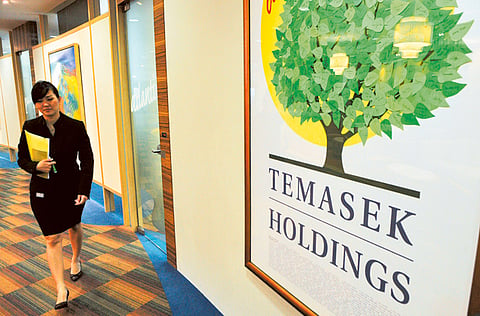Singapore’s Temasek tweaks global portfolio
Country’s investment giant moving away from its finance-based comfort zone into sectors such as retail and African resources

Singapore: As it approaches its 40th year, Singapore investment giant Temasek is stretching its legs, moving away from its finance-based comfort zone into sectors such as retail and African resources to ensure future growth, analysts say.
With worldwide holdings worth 215 billion Singapore dollars (Dh630 billion, $171 billion) as of end March 2013, Temasek is listed as one of the top 10 global players by the US-based Sovereign Wealth Fund Institute.
Its wide spectrum of interests spans banking, telecoms, transport, life sciences and property, while more than 70 per cent of its investments are in Asia.
But with the global economy still readjusting five years after a crippling financial crisis, the firm, established in June 1974, is re-evaluating its portfolio to find new growth areas and minimise its exposure in the event of another downturn.
Analysts say businesses that cater to the needs of the growing middle class in emerging markets, as well as energy and resources, are expected to comprise the main areas of interest for the fund.
“One of the key investment strategies that Temasek has been pursuing in recent years has been to diversify its portfolio to tap into the rapid growth in spending by the middle class in emerging markets,” said Rajiv Biswas, chief Asia Pacific economist at IHS Global Insight.
“The rise of Asia’s consumer middle classes will be one of the key global megatrends driving change in the global economy over the next two decades,” he said.
Kelly Teo, managing director at I.R. Resources, said Temasek’s venture into resources in Africa “shows their willingness to look beyond the norm”.
Tapping consumer growth
Temasek in March bought almost 25 per cent of A.S. Watson, the retail chain owned by Hong Kong’s richest man Li Ka Shing, for HK$44 billion ($5.67 billion).
Its flagship brand Watsons is a household name as Asia’s largest health and beauty retailer, with over 4,000 personal care stores and 1,000 pharmacies in countries including China, Korea and the Ukraine.
A Temasek-led consortium in March offered Sg$2.53 billion to buy out minority shareholders of Olam, which supplies products such as nuts, coffee, cocoa and sugar to food and beverage manufacturers.
Olam also sells its own brands of packaged foods in Africa, which its website describes as the fastest growing continent for consumer products over the next few decades.
Market research firm Euromonitor projects the global retail market to be worth $16.12 trillion by 2018, up from $13.92 trillion in 2013, with the Asia Pacific region accounting for more than a third.
The global beauty and personal care market, which includes grooming products and fragrances, is forecast to be worth $523.51 billion in 2018 from $454.11 billion in 2013.
Temasek has also ramped up investments in the energy sector, venturing into Africa.
In the financial year ending March 2013, Temasek had a net investment of Sg$4.0 billion in the energy and resources sector.
This included stakes in Spain’s integrated oil firm Repsol, Cheniere Energy, a US firm which is building a liquefied natural gas export terminal, and Venari Resources, a US company focused on deep-water exploration in the Gulf of Mexico.
Pavilion Energy, a Temasek wholly-owned company, late last year bought a 20 per cent stake in three natural gas blocks in Tanzania for $1.3 billion.
In April, Temasek invested $150 million in Nigeria’s oil firm Seven Energy.
“African oil and gas developments can play a significant role in supplying Asia’s future energy needs forecast to grow strongly in the next 20-30 years,” said Biswas.
Emerging markets powering energy demand
Energy and resources made up 6.0 percent of Temasek’s global portfolio last year, up from 3.0 per cent in 2011.
The International Energy Agency projects world energy consumption to rise by 56 per cent between 2010 and 2040, much of it coming from emerging markets.
But there are other drivers why Temasek would invest in the sector, said Ravi Krishnaswamy, Asia Pacific vice president for energy and environment practice at business consultancy Frost & Sullivan.
He said at least 30 per cent of oil and gas reserves are in remote areas, requiring new technologies to explore and the necessary infrastructure to deliver them.
Financial services still form the biggest chunk in Temasek’s global portfolio, accounting for 31 per cent as of end March 2013, but this is down from 40 per cent in 2008.
“This was a sector that hurt Temasek which is why they have diversified from it,” said Teoh.
But Temasek spokesman Stephen Forshaw said financial services “will remain a pillar” of the global portfolio.
“Banks are proxies to the growth of economies. Growing companies need access to credit, consumers need access to banking services,” Forshaw said.
Temasek has broadened its exposure beyond banks to insurance, acquiring a 2.0 per cent stake in AIA Group and 1.0 per cent in China’s Ping An Insurance Group.
Dutch banking group ING announced on April 30 that Temasek is investing €425 million ($590 million) in NN Group, an ING insurance unit.
Forshaw said Temasek does not have a fixed target for investments in any sector.
“Over time, we rebalance the portfolio as new opportunities emerge. We view trends, such as the rise of the consumer in growth economies, changes in technologies, ageing populations and urbanisation,” he said.
Sign up for the Daily Briefing
Get the latest news and updates straight to your inbox



